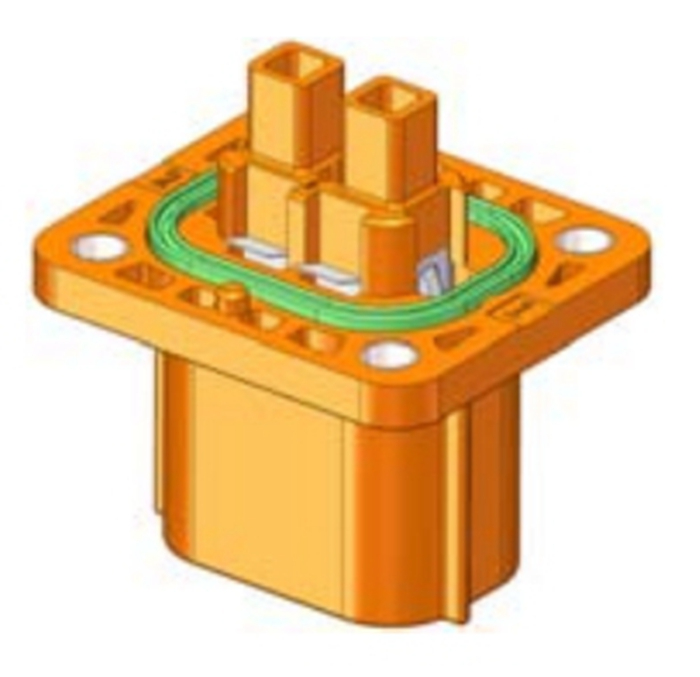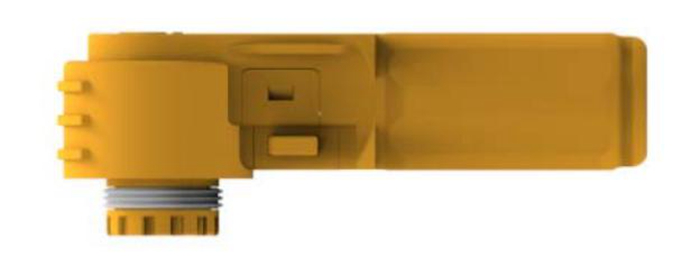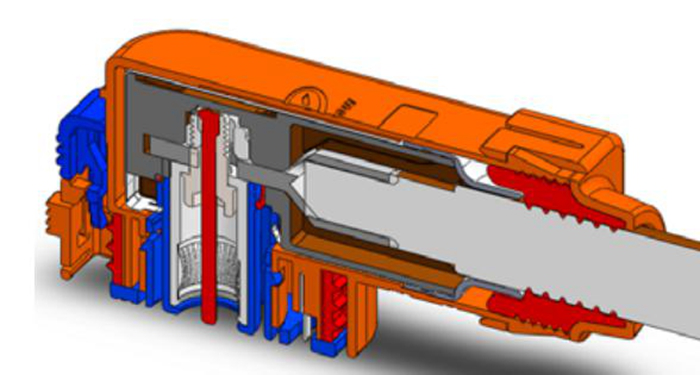New energy vehicle high voltage connector technology
Connectors for new energy vehicles are one of the major categories of connectors. In recent years, with the development of new energy vehicles in the country, they are gradually separated from traditional high-voltage and high-current and traditional low-voltage automotive connectors. Compared with traditional high-voltage and high-current connectors, the working conditions of new energy automobile connectors are more complex and changeable, and the reliability requirements of the connectors are higher. Compared with traditional low-voltage automobile connectors, due to the increase in voltage level ( At present, the voltage of mainstream systems is higher than 300V DC), which increases the risk of human body injury from electric shock, and requires higher connector safety. Therefore, the insulation and protection requirements of the product are improved compared with traditional low-voltage plug-ins.
The role of the connector for new energy vehicles is mainly to ensure the high-voltage interconnection system of the vehicle, that is, to build a bridge where the internal circuit is blocked or isolated, so that current can flow. The composition of the connector for new energy vehicles can generally be divided into three parts: auxiliary structures such as housing and sealing parts, insulating parts, and conductive contact pairs. Through the mating and mutual cooperation between the plug sheath and the socket sheath, the function of connecting and conducting can be achieved. The high-voltage connector is mainly used in the high-voltage and high-current circuit of new energy vehicles, and acts at the same time as the conductive cable. It transmits the energy of the battery pack to various parts of the vehicle system through different electrical circuits, such as battery packs, motor controllers, and DCDC. Body power units such as converters and chargers.
Temperature rise is one of the most important design key items in connector design. Abnormal temperature rise will cause ablation of the connector due to excessive temperature rise.
The temperature rise of the connector is affected by the following factors:
1. Contact resistance: used for conductive connection, the resistance between two contact carriers, such as pinhole-to-plug contact resistance, pinhole tail and wire crimping resistance, threaded connection copper plate and copper plate contact resistance.
2. Material environment heating: When the connector is in a high temperature environment for a long time, the materials used in the connector are all engineering plastics, metal, rubber, etc. Especially engineering plastics require a maximum working temperature of 140℃, but when the ambient temperature of the product is too high, the connector will heat up due to its own contact with internal resistance. After the thermal equilibrium is reached, the ambient temperature is higher than the maximum allowable use of the material. At this time, if the connector is in this environment for a long time, the internal temperature of the internal pinholes of the connector cannot be discharged due to heat, and the internal temperature will continue to rise, and then the connector will generate a lot of heat, causing it to burn Corrosion, which in turn causes the vehicle to burn. This is a very serious problem. Both rubber materials and metal materials have maximum operating temperature limits, and both need to be considered during design.
3. The connection of the plate end: When using bolts to connect the plate ends, preventive measures should be taken to prevent loosening during delivery; at the same time, when bolting, the torsion test must be carried out according to the operating specifications. When using conductive parts to connect the board end with screws, the tightening torque must be controlled according to the torque requirements, otherwise it will cause abnormal temperature rise and ablation of the connection part.
High Voltage Interlock (HVIL)
For the entire high-voltage interconnection system, in order to ensure the safety of the high-voltage system when it is powered on and off, the concept of high-voltage interlock is introduced during the connection design. To put it simply, when the connector is plugged and turned on, the high-voltage circuit is first contacted and turned on, and then the high-voltage interlock signal circuit is turned on; when disconnected, the high-voltage interlock signal is disconnected first, and then the high-voltage circuit is disconnected. Most connector manufacturers put the high voltage interlock design inside the connector, and some manufacturers put the high voltage interlock outside the mating cavity through the auxiliary structure design. It is very important to ensure the stability of the high-voltage interlock circuit. If the high-voltage interlock is not continuous, the possible impact will be very bad. For example, when the car is driving, the signal of the high-voltage interlock circuit is abnormal, causing the whole car to suddenly lose power and fail to operate normally, which will cause a traffic accident.
Locking Structure
Understand that the real secondary lock does not have a secondary protection function, but to protect it more effectively. The real meaning is that after the primary lock, if the primary lock fails or no operation is verified in place, the secondary lock is It is very important to ensure that the first lock is protected after the first lock is locked. The secondary locking structure is combined with the most commonly used moment arm mechanism in the primary lock. Because the primary locking is related to the insertion and extraction force, a form similar to the moment arm mechanism is required according to the mechanical design concept, so as to achieve both labor saving and Insert the connector in place easily.
Protection Level
The protection of the connector is mainly divided into three arrangements:
The first is the board end seal: the board end is the connector socket end using four screws, which are installed by mechanical connection. This is a more commonly used structure, but there are also some more special structures (Figure 3);

The second is the plug-to-head seal: the plug-to-head plug means that the male end contains the female end or the female end contains the male end, and the rubber part is used for protection between the radial and axial directions (Figure 4);

The third is the wire end seal, the protective seal between the wire end connector and the cable (Figure 5)

With the development of the market for high-voltage connectors for electric vehicles, the performance requirements of OEMs for product protection are constantly improving. In the early stage of industry development, the protection requirements of IPI67 can already satisfy most customers. However, with the failure of the connector products on the market in the later period, there are more and more cases of product leakage, insulation failure, and even ablation.
Electromagnetic Shielding
Electric vehicles have a lot of electronic devices, and electric current will generate magnetic fields, and the whole vehicle parts must have the ability to resist interference. Especially as electric vehicles are now a carrier, unmanned driving will be developed more on this basis, so this technical issue is very important. For high-voltage systems, shielded connectors and cables are very important, but we must give priority to system-level layout. This is a prerequisite. If your OBC, the location of your layout, including the system DCDC, does it have some congenital problems? No matter how good the connector is, there will be various signal interference problems. Therefore, first consider the system type, and then consider the component level. Regarding the connector shielding effectiveness, two methods are generally used. In the first way, the metal shield in the plastic connector, the cable shield layer will be connected with the shield layer of the metal shell to form an effective 360° shielding layer. The second method is to directly connect the wire to the shielding layer of the cable. This method is also commonly used by existing manufacturers. We call it spring contact, which is actually a spring connection. The advantages of this structure are also many, because the size and space will be smaller, and it will have more contact points; in most cases, the connection between the wire and the shielding layer will be carried out in the form of metal inner and outer rings. In crimping, the shielding layer is placed between two metal rings, and the shielding layer and the metal ring are tightly fixed by cold compression deformation. In addition, we also have a shielding method, which uses a structure similar to a watchband spring to replace the spring connection. This structure is often used in military products and has mature technology.
Connector Material
The material of the connector insulation is generally PA66, PBT, ABS, PC, etc. The contact material is generally made of brass, phosphor bronze, beryllium copper, etc., but the most widely used material abroad is copper nickel silicon material. The connector shell material is generally divided into two kinds of materials: plastic and metal.
Regarding how to choose plastic or metal materials, there are generally the following reference points:
1. Lightweight
Due to the demand for lightweight vehicles, especially passenger car manufacturers, they will try their best to choose plastic connectors on the premise of meeting product performance to control the weight of the vehicle.
2. The use environment of the product
Because the mechanical strength of metal materials is better than plastic. Therefore, in some harsh environments, metal connectors are more suitable.
3. Shield implementation
Regarding the shielded connector, since the shell of the metal connector is used for conducting the shielding, it forms a carrier for shielding protection.
Connector Selection
1. Connector selection process
2. Interpretation of common technical parameters of connectors
(1) Use position: as the name implies, that is: the application position of the connector on different high-voltage electrical appliances in the vehicle
(2) Rated voltage: The maximum voltage at which electrical equipment (including electricity and power supply equipment) can work stably for a long time. The rated voltage is proportional to the creepage distance and the electrical clearance. In other words, the higher the rated voltage requirement, the larger or longer the connector.
(3) Rated current: The rated current of electrical equipment refers to the maximum current that is allowed to pass for a long time when the heating does not exceed the long-term heating allowable temperature under the reference ambient temperature and the rated voltage working condition. For electric vehicles, P=UI, and the rated current is determined by the power P of the electrical equipment and the output voltage U.
Peak current: the maximum current value generated by an electric vehicle at the moment of rapid acceleration, climbing, or overload.
The current-carrying cross-sectional area is proportional to the rated current of the connector. In other words, the larger the pin/hole/wire cross-section, the larger the current it can pass, and the larger the connector.
(4) HVIL (High Voltage Interlock)
1. Design HVIL function purpose
Confirm the integrity of the entire high-voltage system. When the circuit of the high-voltage system is disconnected or the integrity is damaged, the safety measures of the whole vehicle will be activated.
2. Realization of HVIL function
a. The entire system needs to be structured, which must be designed during system development
b. Mainly through the connector to complete
c. The HVIL circuit is a low-voltage circuit, which is independent of the power circuit
3. The realization principle of connector HVIL function
The power and signal terminals should meet:
——When connecting, the power terminal is connected first, and the signal terminal is connected later.
——When disconnected, the signal terminal is disconnected first, and the power terminal is disconnected later. To
(5) Shield
Alternating electric field shielding: In order to reduce the coupling interference voltage of the alternating electric field to the sensitive circuit, a metal shield with good conductivity can be set between the interference source and the sensitive circuit, and the metal shield can be grounded. The main difference between shielded and unshielded connectors is whether a metal shield with good conductivity is provided.
(6) Protection level
The IP protection level is composed of two numbers. The first marked number indicates the level of protection against dust and foreign objects, and the second marked number indicates the degree of airtightness of the appliance against moisture and water intrusion. The larger the number is, the higher the protection level will be.
(7) Way of outlet
Mainly refers to the angle between the outlet angle of the cable at the end of the electrical connector plug and the normal direction of the socket installation surface. According to this division, there are common 90° (curved) and 180° (straight) outlet electrical connectors.
Option Considerations
(1) The voltage selection needs to be matched: the rated voltage of the whole vehicle after load calculation should be less than or equal to the rated voltage of the connector. If the working voltage of the whole vehicle exceeds the rated voltage of the connector for a long time, the electrical connector has the risk of creeping and ablation.
(2) The current selection needs to be matched: the rated current of the whole vehicle after the load calculation should be less than or equal to the rated current of the connector. If the working current of the whole vehicle exceeds the rated current of the connector for a long time, the electrical connector has the risk of overload and ablation. ,
(3) Cable selection needs to be matched: The vehicle cable selection matching is divided into cable current-carrying matching and cable and connector sealing matching.
Seal matching: The connector and the cable seal rely on the elastic compression of the rubber seal to provide the contact pressure between the two, so as to achieve reliable protection performance. For the current-carrying section of the same specification, the cable can have different outer diameters.
(4) The whole vehicle needs flexible wiring: For the wiring of the whole vehicle, all OEMs have requirements for bending radius and slack; according to the use of the connector in the whole vehicle, it is recommended that after the wiring harness is assembled, the connector terminal itself is not stressed. Only when the wiring harness as a whole is subjected to vibrations, impacts and relative displacement with the vehicle body due to the operation of the car, the strain relief can be achieved through the flexibility of the wiring harness. Even if a small amount of strain is transmitted to the connector terminals, the stress generated does not exceed the design retention force of the terminals in the connector .
Summary
By analyzing the main technical parameters and selection principles of the new energy connector, as we continue to collect various data feedback, if we are abroad, even the connector manufacturer has set a lot of vehicle data returns, they will form an alliance, they will continue to improve based on the data to achieve an optimal product.



















View More(Total0)Comment Lists